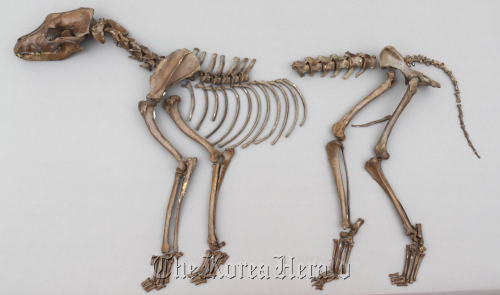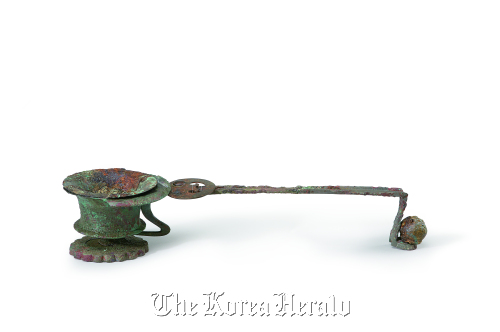Exhibition features more than 2,300 Silla artifacts, from bones of dogs to metal tools
In the days of Korea’s Silla Kingdom (B.C. 57―A.D. 935), people had an unusual way of wishing for good fortune and chasing away evil spirits.
During their prayers for prosperity and fortune, they’d bury a number of personal items, such as roof tiles, well buckets and plates, underground or in the wells of various locations.
The National Museum of Korea’s new exhibition, titled “Opening of Time Capsules: Wondrous Expedition to the Past,” features some 2,300 items that were discovered at a site near Gyeongju National Museum in Gyeongju, North Gyeongsang Province, back in 2000. The items are being shown to the public after some 1,200 years underground.
It is believed that the people of Silla buried certain items, such as earthenware, wooden combs, golden plates and spoons, in their wells whenever they were in desperate need for rain or wanted to drive away diseases and other misfortunes. It is also believed that they held spiritual ceremonies while burying the items.
In the days of Korea’s Silla Kingdom (B.C. 57―A.D. 935), people had an unusual way of wishing for good fortune and chasing away evil spirits.
During their prayers for prosperity and fortune, they’d bury a number of personal items, such as roof tiles, well buckets and plates, underground or in the wells of various locations.
The National Museum of Korea’s new exhibition, titled “Opening of Time Capsules: Wondrous Expedition to the Past,” features some 2,300 items that were discovered at a site near Gyeongju National Museum in Gyeongju, North Gyeongsang Province, back in 2000. The items are being shown to the public after some 1,200 years underground.
It is believed that the people of Silla buried certain items, such as earthenware, wooden combs, golden plates and spoons, in their wells whenever they were in desperate need for rain or wanted to drive away diseases and other misfortunes. It is also believed that they held spiritual ceremonies while burying the items.

At the site, the bones of little children and various animals were also discovered. Curator Kim Hyun-hee from the museum said that children and animals may have been sacrificed during the well ceremonies in Silla.
“From what we see, it doesn’t seem likely that they fell into the well by accident,” she told The Korea Herald. “And the bones of the children and the animals were found together, tangled with one another. We are not 100 percent sure, but it seems like they were sacrificed during the well ceremonies.”
The second part of the exhibition features some 500 treasures found in a cauldron, which was excavated from a site in Malheul-ri in Changnyeong, South Gyeongsang Province.
It is believed that there was a Buddhist temple at the site during the Silla period. The 500 metal treasures, including an incense burner, golden bells, and a Buddhist ornamental board made of gold and bronze, were hidden under metal scraps in the cauldron.

“It seems like someone had to hide the treasures with the metal scraps in the temple,” said Kim. “We are assuming that the person left them in the cauldron, thinking they’d come back someday to the temple.”
This part of the exhibition is divided into three themes of light, sounds and fragrance, featuring the purpose of every religious relic.
“The fragrance created by the incense burner was believed to act as an intercessor between human beings and Buddha,” said Kim. “The golden bells and its sounds were used to enlighten Buddhists, while the gilt-bronze ornament board, which dazzled with its own material, portrayed Buddha and his bright glory.”
“Opening of Time Capsules: Wondrous Expedition to the Past,” which opened on Monday, runs until May 6. For more information, call (02) 2077-9000.
By Claire Lee (dyc@heraldcorp.com)










![[From the Scene] Monks, Buddhists hail return of remains of Buddhas](http://res.heraldm.com/phpwas/restmb_idxmake.php?idx=644&simg=/content/image/2024/04/19/20240419050617_0.jpg&u=20240419175937)



![[From the Scene] Monks, Buddhists hail return of remains of Buddhas](http://res.heraldm.com/phpwas/restmb_idxmake.php?idx=652&simg=/content/image/2024/04/19/20240419050617_0.jpg&u=20240419175937)

![[KH Explains] Hyundai's full hybrid edge to pay off amid slow transition to pure EVs](http://res.heraldm.com/phpwas/restmb_idxmake.php?idx=652&simg=/content/image/2024/04/18/20240418050645_0.jpg&u=20240419100350)

![[Today’s K-pop] Illit drops debut single remix](http://res.heraldm.com/phpwas/restmb_idxmake.php?idx=642&simg=/content/image/2024/04/19/20240419050612_0.jpg&u=)